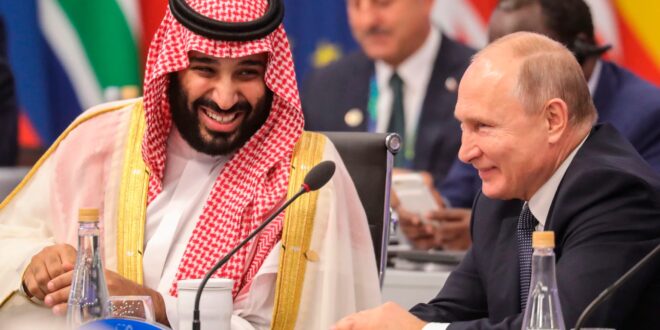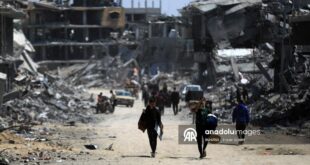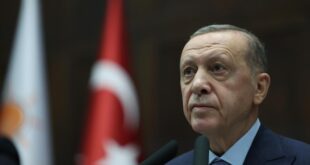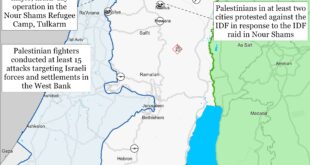Riyadh and Tehran are rivals on almost everything, but they are both supporting Russia’s war effort to give Washington a black eye.
As Russia’s aggression against Ukraine intensifies, two Middle Eastern powers that are usually on opposite sides in most conflicts are aiding Moscow. Iran is reportedly delivering weapons, namely drones and possibly missiles, to Russia for its use in Ukraine. Saudi Arabia is weaponizing its oil production in ways that help keep Moscow solvent and inflict greater pain across Western capitals ahead of a cold winter. Riyadh (a long-standing Western partner) and Tehran (a long-standing Western foe) are both largely motivated by one factor: the United States.
The energy crisis generated because of Russia’s invasion of Ukraine has given a major boost to Saudi Arabia’s geopolitical status. And Riyadh is playing an offensive game. This month, Riyadh doubled down on this strategy by driving OPEC+ (consisting of OPEC members plus other producers who are not members, such as Russia) to cut collective production by a whopping 2 million barrels per day.
This comes at a time when the United States and Europe have been calling for increased production to lower prices in ways that both deplete Russian coffers and help ease the cost-of-living crisis in the West. Sanctions have forced Russia to sell its oil, including to Saudi Arabia, at below-market prices. As such, a higher baseline price is the main way for Moscow to still make a profit from its energy and sustain its expensive and failing war efforts. Riyadh’s own preliminary 2023 budget, including a nice surplus of approximately $2.4 billion, was calculated by factoring in a price of $76 per barrel, which negates the urgency to intervene on prices of around $90 per barrel, as they were in early October. At the very least, OPEC+ could have waited another month, as White House officials asked Saudi Crown Prince Mohammad bin Salman to do, so the cuts would not have entered into force just before U.S. midterm elections.
On the Iranian side, despite continued official statements that Iran is a neutral actor and has not transferred weapons into Ukraine, it’s clear the conflict has become a new theater where Tehran feels it can cement its ties with Russia to weaken the United States. Ukrainian officials maintain that a large inventory of Iranian-made drones have been deployed by Russia in Ukraine with deadly effect. There are also U.S. reports of Iranian military trainers in Crimea and that Tehran has agreed to deliver to Russia Iranian-made surface-to-surface missiles for use in Ukraine.
It is clear that both Iran and Saudi Arabia are using the Ukraine conflict to weaken Western interests. What is less clear is how the West can most effectively shift its position.
Several factors are driving Riyadh and Tehran, but the biggest motivation is to strengthen their own hands against the United States in an increasingly multipolar world order. After decades of being pressured and dictated by Western powers, regional players like Iran and Saudi Arabia are signaling to global giants that their relationship is now a two-way street and are increasingly looking to cement ties with non-Western actors to affirm their freedom of action.
In this context, the Saudi refusal to cooperate on oil policy with the United States is not at all about siding with Russia. Unlike Iran, Saudi Arabia voted against Russia in all of the key Ukraine-related United Nations General Assembly resolutions, provided $400 million in aid to Ukraine, and backed a deal that released Western nationals captured by Russia while fighting alongside Ukraine. Saudi Arabia’s recent moves are more about not siding with Washington, which it feels is no longer a dependable partner.
A fundamental premise of the decadeslong U.S.-Saudi partnership—oil in exchange for security—has been definitively dented by both the Obama and Trump administrations. Former U.S. President Barack Obama signed a nuclear pact with Iran, and former U.S. President Donald Trump glossed over key Saudi infrastructures being hit by missiles and drones launched by Iranian-backed forces in 2019. Had it not been for the necessity to counter Russia in the energy market, U.S. President Joe Biden would have probably continued to ostracize Mohammed bin Salman for years.
Saudi policymakers are now sending clear messages to the U.S. government: Riyadh is in a Saudi-first mood, renegotiation of the fundamentals of their partnership will entail a downsizing of expectations, the Middle East region has become multipolar, and Saudi Arabia feels entitled to play a game of extreme strategic hedging.
Meanwhile, Iran is diversifying its options to act as a safety net as ties with the West worsen and the prospect of a restoration of the 2015 nuclear deal looks increasingly slim. If nuclear talks collapse, Tehran expects further Western (and Israeli) political, economic, and military pressure. Iran is doubling down on its military partnership with Russia, pushing for greater economic ties with China, and deepening diplomacy with its Persian Gulf and Asian neighbors. By building up these relationships, Tehran aims to disarm the West from being able to isolate it in the same way the Obama administration managed to do so through sanctions and by unifying the international community against Iran’s nuclear program.
Tehran has also been looking for every avenue to weaken the ability of the United States to isolate and confront Iran. One way it has sought to achieve this is through forging deeper security ties with Russia—in particular, by following Moscow’s decision to engage militarily in Syria when Iran called on its help in 2015 to save Bashar al-Assad’s regime.
Now, in Russia’s time of need, it is hard to imagine Iran rejecting requests from Moscow for weaponry that bring with it financial incentives and geopolitical influence on the world stage. Ukraine also presents Iran with a test case to showcase its indigenous arms capabilities despite decades of sanctions, acting as a warning to Iran’s own regional foes that it could inflict considerable damage using its homegrown weapons.
To regain influence and leverage with both Saudi Arabia and Iran, the United States should acknowledge these trends as tied to the definitive emergence of a multipolar world order. In fact, Washington should reset its thinking paradigms, developed on an outdated premise of U.S. hegemony in the Middle East.
As usual with Iran, there is a heavy focus on imposing sanctions. Europe and the United States have imposed new sanctions to target individuals and entities over drones supplied to Russia for its use in Ukraine. But Iran remains one of the most heavily sanctioned countries in the world; its military is especially hard hit. Besides virtue signaling, it is clear that more Western sanctions are not going to alter Iran’s behavior. Europe and United States should focus instead on ways they can interdict and counter Iranian weapons used in Ukraine as well as increase the tangible costs for Iran with its own public.
The public dimension is particularly important given Iran’s leadership is grappling with nationwide protests that have entered their second month, fueled by decades of grievances and triggered by the death of a young woman—Mahsa Amini—while in police custody. These protests have further eroded the legitimacy of state authorities in Iran. And at a time when protesters are calling for accountability and regime change, the West should continue to expose Iran’s role in supporting Russia’s invasion of Ukraine. This is a particularly sensitive topic in Iranian public debate given the role that the West played in supporting then-Iraqi leader Saddam Hussein during the Iran-Iraq War that led to the death of thousands of people in Iran and left many communities dealing with the long-term impact of Saddam’s chemical weapons use. This experience continues to tarnish the standing of the West with large segments of Iran’s public, including members of the Islamic Revolutionary Guard Corps and Basij who were at the front lines. Public exposure of Iran’s support of Russia puts a spotlight on Iranian authorities to answer to their own public why they are choosing to back an aggressor. And unlike in Syria, where Iran defends its actions based on supporting state actors to fight terrorism and U.S. aggression, Iran is now helping Russia weaken a state actor in Ukraine.
The fate of talks to restore the nuclear deal could also be used to influence Iran over Ukraine. Although it’s clear that many in Tehran are skeptical about a new deal, it is also clear that the possible economic benefits have kept Iran coming back to talks—and could be more of an incentive than ever given mounting domestic pressures.
France and the United Kingdom, both parties to the 2015 nuclear deal, have called Iranian drone supplies to Russia a violation of Iran’s obligations under U.N. Security Council Resolution 2231. They maintain this resolution bans Iran (until 2030) from transferring delivery systems—such as drones—capable of delivering a nuclear weapon. This is important in signaling to Tehran that the deeper Iran engages with Russia in Ukraine, the more it stands to pollute the nuclear diplomacy track. Even if the nuclear deal is restored, Iran cannot expect the European market to welcome it with open arms when Tehran is allied with Moscow in Ukraine.
Western policymakers should also warn Iran that its stance in Ukraine could open the door for a new unpredictable proxy front with Israel. Despite Israel’s delicate relationship management with Moscow, Israel has reportedly provided Ukraine with intelligence regarding Iranian drones. The shadow war between Iran and Israel could intensify in Ukraine in similar ways to how Israel has targeted Iranian personnel and assets in Syria. For example, Israel may assist Ukrainian forces to target sites with Iranian military advisors who are collaborating with Russia.
On the Saudi side, senior U.S. policymakers and the White House have openly accused Riyadh of collusion with Russia. Given bipartisan U.S. reluctance to revert to a dominant security posture in the Middle East, Washington should accept the premise that its relationship with Saudi Arabia needs a reboot, right-sizing it to focus on clearly identified core interests of both sides. Short of an (unlikely) full-on coercive approach, half-based punitive measures against Riyadh will not have the structural impact that Washington needs and will plunge the relationship deeper into a downward spiral as well as energy prices into an upward one. The ideal course of action is to be specific and target the Saudi-Russia relationship.
First, the United States should adopt creative measures to beef up its own resilience vis-à-vis not just Saudi Arabia but all hydrocarbon producers. A G-7 price cap on Russian oil—set to become operational in December—must now be expedited to November. Europe and the United States should also intensify cooperation on long-term liquified natural gas (LNG) supplies and the oil-to-LNG transition, especially coordinating on pricing, investments, incentives, and regulations. Second, the idea that Republicans would be much more lenient toward a Saudi-Russian engagement once they are back in power weakens the United States. It is in the national interest to instead activate a bipartisan effort before the U.S. midterm elections, focused on revisiting the NOPEC (or No Oil Producing and Exporting Cartels) Act to target only foreign actors, preserving the U.S. energy industry and launching a blue ribbon audit of Russian-Saudi financial ties, especially between the two sovereign wealth funds.
Finally, the most impactful strategy remains finding creative ways to remind Tehran and Riyadh that Moscow is first and foremost a competitor, leveraging how Russia is offering larger and larger volumes of discounted crude to traditional Saudi and Iranian markets in China and Asia more widely.
Iran and Saudi Arabia have decided to support Russia directly or indirectly in its war effort in Ukraine. In assessing how to manage regional powers, the United States should shift away from the traditional thinking that it can make a strategic bet on Saudi Arabia or that a containment policy is the solution to all areas of confrontation with Iran.
The West needs new, more innovative, and more effective policies to respond to regional powers in the multipolar world order that has been expedited by the clash with Russia.
 Eurasia Press & News
Eurasia Press & News




